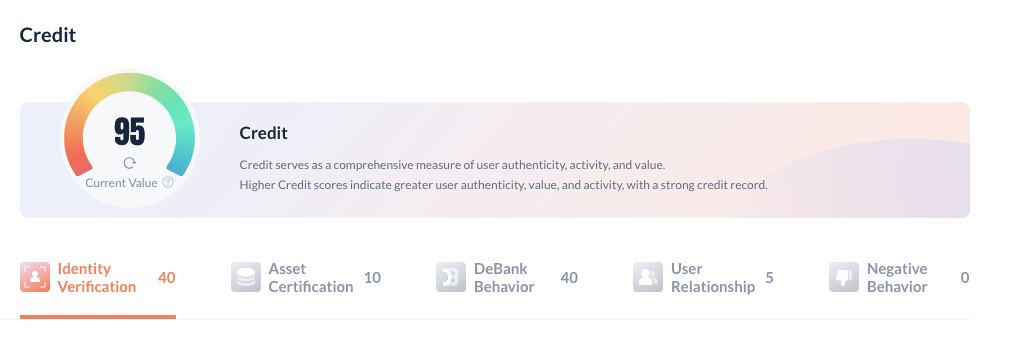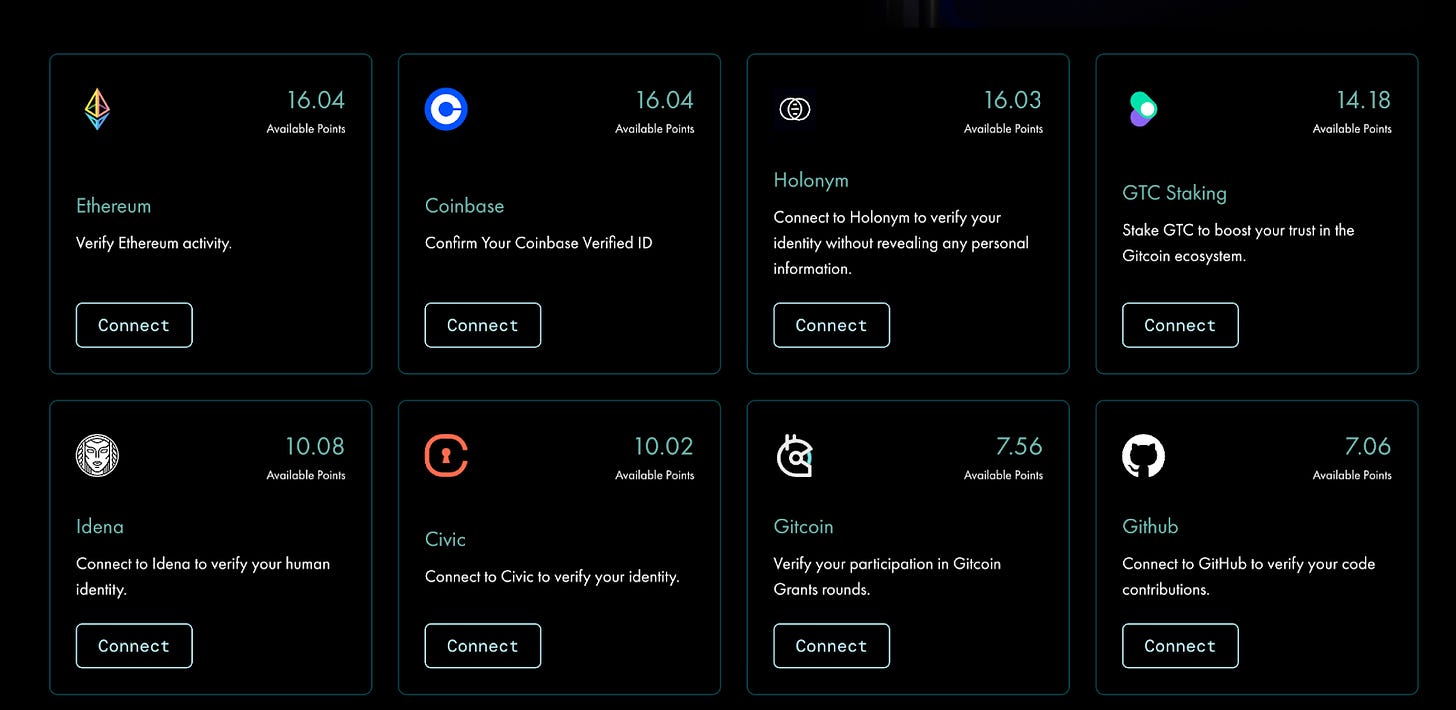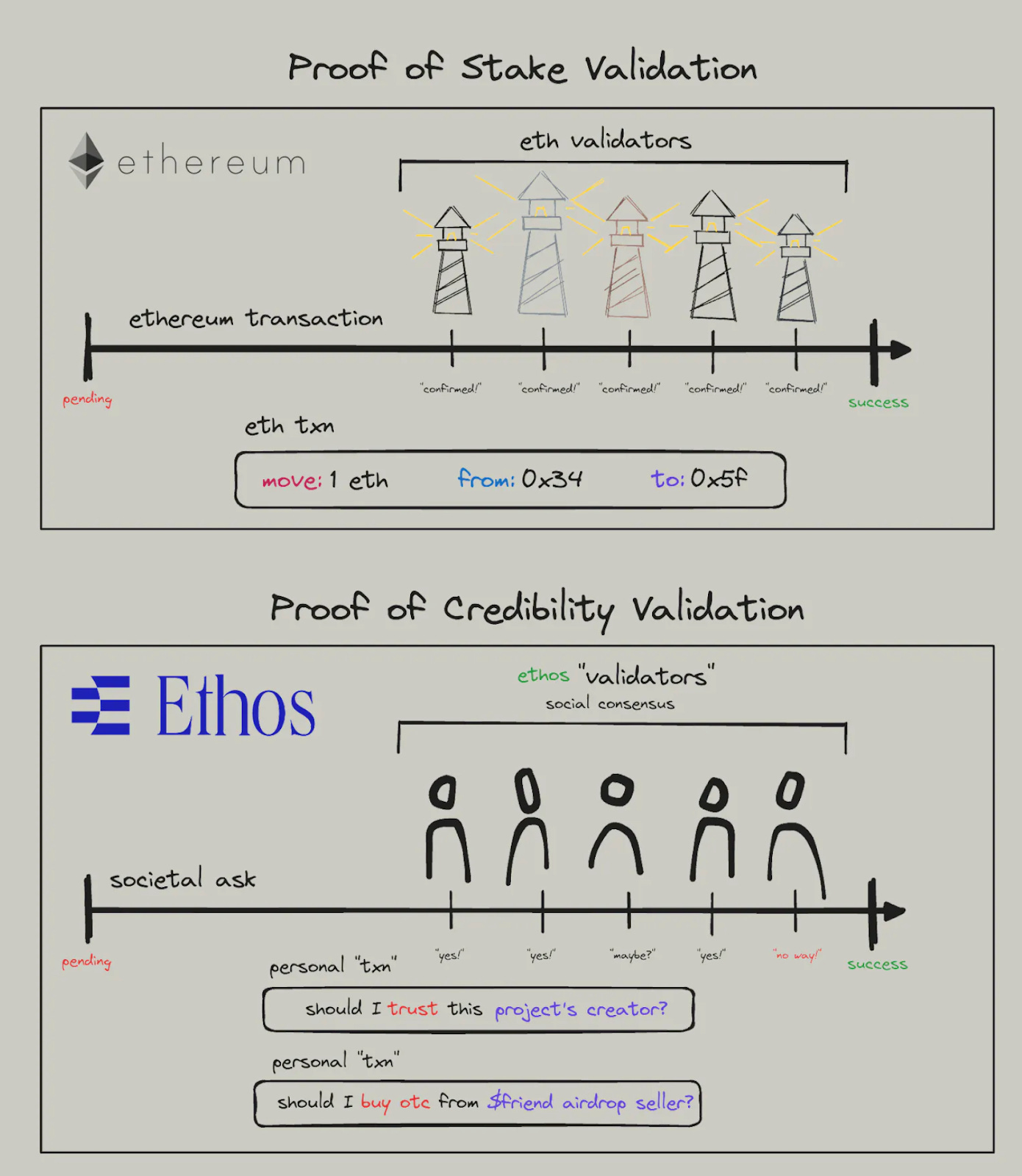The importance of On-chain reputation
Building a standardized and general framework to assess reputation in decentralized systems
A lot has been said over the years about on-chain reputation.
Since 2017, projects have tried to solve this dilemma and empower on-chain users to leverage a reputation layer to know who they are dealing with.
Nowadays, this seems more important than ever, with all the rugs, SocialFi, and celebrities launching shitcoins left and right.
This article introduces the concept of on-chain reputation and its importance, focusing on projects working on it, such as Debank and Ethos Network.
On-Chain Reputation
On-chain reputation answers a simple question:
How do we assess the trustworthiness of the people we interact with in a decentralized system?
In centralized systems, third parties often ensure this reputation (e.g., a credit score, the Interpol red list, a bank account).
Is there a way to replicate reputation assurance in a distributed system?
These efforts go beyond single protocols, trying to innovate in the space. To be applicable, this reputation system has to go beyond a single protocol and create a unique set of standards that can be identified across Web2 and Web3 platforms, establishing a common cross-chain framework for on-chain reputation.
Anything short of being a new standard would make this process useless.
According to a16z, “to mainstream decentralized identity, we must first establish systems that map people’s relevant off-chain experiences and affiliations on-chain”, then “we must build mechanisms to standardize, process, and prioritize the influx of data that will be added on-chain” and “solve endemic challenges to decentralized identity, including the lack of context around on-chain records and issues around gaining access to the decentralized web”.
Currently, even block explorers record very basic inputs. Without additional context for transactions, it will be much harder to map and assign a reputational score for them.
For instance, receiving an NFT as part of a swap should have a different weight than doing so because of extraordinary community contributions to that project.
Furthermore, in crypto, reputation takes various forms, such as protocol trust, lending and borrowing credit scores, and project founders’ track records.
Only once all of this is taken into account will this system be applicable to many use cases, factoring on-chain reputation into “offline activities” based on the “openly queryable nature of decentralized identities.”
Three steps:
Record data on chain
Map and interpret it
Translation into “reputational score”
A Truly Standardized Reputation
In their Request for Builders, the Base team outlines how they see on-chain reputation as fundamental to its success. They compare “on-chain” as the next “online,” with reputation playing a massive role in each on-chain account.
Within this context, “reputation protocols” could create more trust on-chain. They postulate this could look something like a FICO (the most recognizable credit score name) or a Google Page Rank score.
Wallets could implement these standards as a fraud prevention mechanism, with warnings about risky addresses. We’ve seen how Rabby has pioneered the introduction of warnings about new contracts or scammy tokens.
Others who have introduced some reputational measures include blockchain analytics companies like Chainalysis, based on on-chain behavior, and DeBank, with the creation of the DeBank Credit score.
The credit score is “a comprehensive measure of user authenticity, activity, and value.” A higher score means more activity and user authenticity, but in its current state DeBank Credit does not stand as a proxy for reputation.
Furthermore, we can also observe how much weight is given to formal identity verification, which remains a controversial topic within crypto.
A successful example of a reputational mechanism is the Gitcoin Passport.
Gitcoin Passport describes itself as an “identity verification aggregator application”.
Just like a normal passport, users can collect stamps by verifying previous activity or carrying out tasks and verification from different Web2 and Web3 authenticators:
Holonym (KYC)
Civic (Biometrics)
Google and LinkedIn (Web2)
Guild and Snapshot (web3),
These stamps increase the Default Humanity Score, a proxy for your trustworthiness to web3 projects, assigned to each user. A higher Humanity Score gives access to more opportunities, and a minimum of 20 is required to be considered a human.
Here’s an example of the stamps that can be collected:
The great thing about Passport is that it preserves user privacy, using a zero-knowledge methodology where “a verifiable credential is created that proves that the user has performed the specific activity, but none of the personally identifiable information is collected.”
Another interesting attempt to create a “proof of verifiable validation” is being carried out by the Ethos Network.
Ethos is developing a “credibility platform” integrated within the broader ecosystem and not limited to a single dApp. This platform could be incorporated into existing interfaces (Chrome plugins, Metamask snaps) and dApps.
The blueprint of this new social consensus is similar to the proof of stake, with users acting as “social validators”.
Users can stake in people, showing they trust them
Bad actors can be slashed
Providers of social consensus can be rewarded
Ethos introduces financial rewards and penalties, ensuring that:
Reputation is protected by financial security, and it becomes expensive to fake a reputation
Reputation is valuable
It’s easier to observe social interactions
At the same time, it is essential to strike a balance and ensure that reputation cannot simply be bought.
On Ethos Network, users will be able to:
Review: to develop a reputation beyond providing financial stakes
Vouch: Similar to staking, users can voice their ETH in other people and earn staked ETH yield. The person you vouched for will get 10% of that yield to incentivize validators and referrals.
Slash: If validators act in bad faith, those who have vouched ETH to them can propose a slashing, removing up to 10% of the offender's staked ETH from the Ethos contract. Those who propose a rejected slashing will be penalized.
Attest: reflecting authority, reputation, and influence from other sources
All of these mechanisms will be translated into a single Credibility Score.
While less focused on on-chain reputation as such, other notable mentions in this sector are:
Worldcoin: this VC-run behemoth promises to scan your iris and airdrop some WLD tokens for the inconvenience.
Whether their purpose is noble or utopian is open to discussion. Nonetheless, they bring about proof of humanity thanks to the biometric scans of users' iris. While this opens up new avenues for risk, it is an exciting experiment.
ENS: translating crypto addresses into human-readable names facilitating “on-chain messaging”
A Long Road Ahead
Developing a truly standardized and generalized on-chain reputation system will be a long and dark road, and several challenges will arise.
Centralized Solutions: The main one is to ensure that all these systems are truly decentralized and not controlled by a centralized party such as the case of Worldcoin or even Gitcoin Passport.
How can we achieve on-chain reputation in a decentralized manner? Anything less will make the whole system lose its trustless element.
Crypto reputation can be gamed/Purchased
Must be privacy-preserving
Must go beyond single-wallet attachments and be generally applicable
This implementation will be a combined effort by all actors, wallets, block explorers, dApps and networks.
The vision using practical use cases
What’s the final vision for on-chain reputation?
Here’s some examples and practical situations where on-chain identity could help.
Open CVs: anyone could assess the reputation of other participants by assigning a single reputational score to each user. Furthermore, every article written, contribution, or community engagement will be recorded and could be used as proof of reputation.
Celebs launching Tokens: with celebrity tokens being the new meta, the data from these launches could be used to determine a trust profile for each celebrity. We have seen how many of them have run serial scams. This could be partially solved by having a quick risk assessment for them which could show users to be careful with these tokens.
Meme developers: It’s peak time for meme developers. However, many abuse this power to run pump-and-dump and even outright scams. We’ve seen several figures acting as serial meme developers, continually running scams. Identifying the deployer of a token as a previous scammer is of great utility for users to run their risk assessments with more knowledge.
KOL dumping: One of Crypto Twitter's staples is KOLs shilling their bags while dumping on their followers. Imagine if you could have a reputational ranking if your favorite KOLs or just know who’s an outright dumper and liar.
Loyalty Programs: developing an on-chain reputation system would allow dApps to have much deeper info on user interactions, creating custom-made programs that’d focus on rewarding high-quality interactions of high value to the protocols.
Additional Existing Reputation Tools
Aside from the ones mentioned, there’s already a variety of tools contributing to trust and accountability.
Reputation Building and Tracking
Collab.Land: it’s an NFT-gated bot verifies ownership and DAO contributing.
Karma: visibility in DAO contributions
PNTHN: tracks DAO member reputation
SOURC3: platform on-chain reputation management
Reputation and ID Verification
Pentacle: helps users navigate protocols
ONT ID: identify framework for decentralized identifiers and verifiable credentials
Krebit: users can prove their identity without revealing it, preserving privacy
Orange Protocol: multi-chain reputation systems as verifiable credentials
OutDID: ZK proofs for private ID verification
Reputation and Governance
Metopia: reputation system for governance
Astraly: on-chain reputation and reputation-based token-distribution platform
Spect: no-code tool, aiding DAO contributors to create sub-DAOs
SourceCred: helps incentivize contributors, rewarding high-quality participation







